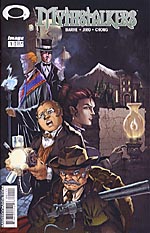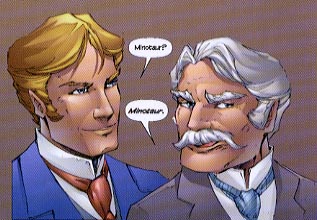 Written by Douglass Barre
Written by Douglass Barre
Art by Jiro
32 pages, color
Published by Image Comics
The Victorian Era has always been a popular time period for science-fiction. This could be in part because of Jules Verne’s novels, which in many ways planted the seeds for modern science-fiction. With comics like The League of Extraordinary Gentlemen high in popularity, it’s not a surprise to see more and more comics in this era like Mythstalkers showing up. The real question is, when the charm of the setting wears off, how is the work itself?
In the 1860s, an adventurer’s club called the Society of Cryptozoological Research mysteriously vanished. Now, some thirty years later the leader’s son, Lord Kenneth Valence of Marson, has reformed the club to try and not only explore the unknown, but to discover his father’s missing footprints. But it seems that someone doesn’t want the club around—and who may be connected with the club’s original disappearance.
Douglass Barre’s story in Mythstalkers #1 is fundamentally a good one. As a basic plot, I like it; a group searching for the unknown, both the fantastic and the twists of fate that separated a son from his father. The problem is in the actual execution; it’s very clumsy and has all the subtlety of a sledgehammer. Characters don’t sound like people, but spout expository dialogue that sounds anything but natural. Early on in the book, Kenneth swears that he’ll discover the strange things out there, vowing, “And I’m damned if I’m not going to learn all I can from them.” One of the other characters instantly has a little thought balloon appear with the line, “Especially if it includes your father’s final port of call, eh?” The cliché will have just about anyone cringing, and the pain just keeps on coming. It’s a shame, because Mythstalkers could be an entertaining book, but the continual dialogue disasters and over-emphasis of everything continually pulls the reader out of the book.
 Likewise, on the surface Jiro’s art seems like it should be good. It looks like it’s using the ever-increasingly popular technique of digitally coloring an artist’s raw pencils, and when done right it can look fantastic. Unfortunately. this technique can also expose any deficiencies in the artist’s work. Jiro’s basic character designs aren’t bad; he’s certainly taken a close look at Victorian fashions when drawing this book. The problem is, the art isn’t as dynamic as it could be. Characters’s expressions seem to only be “surprised/concerned” or “happy”, but very little others. The worst is when two characters are standing next to each other and they’ve got the exact same face, just slightly different hair. Ironically, it’s the little details that stand out as being accomplished; the backgrounds look really nice and a lot of attention has been lavished on them to make them look just right. If the main characters could catch up with the skill level being put on them, the end result would be a lot more stunning.
Likewise, on the surface Jiro’s art seems like it should be good. It looks like it’s using the ever-increasingly popular technique of digitally coloring an artist’s raw pencils, and when done right it can look fantastic. Unfortunately. this technique can also expose any deficiencies in the artist’s work. Jiro’s basic character designs aren’t bad; he’s certainly taken a close look at Victorian fashions when drawing this book. The problem is, the art isn’t as dynamic as it could be. Characters’s expressions seem to only be “surprised/concerned” or “happy”, but very little others. The worst is when two characters are standing next to each other and they’ve got the exact same face, just slightly different hair. Ironically, it’s the little details that stand out as being accomplished; the backgrounds look really nice and a lot of attention has been lavished on them to make them look just right. If the main characters could catch up with the skill level being put on them, the end result would be a lot more stunning.
In the end, one final question remains: did this really need to be in the Victorian Era? This book could just as easily be transplanted into the modern day with barely a change. The only real difference is that when you strip away the charm of the setting, the reality sets in that Mythstalkers is just a mediocre book. It still has a lot of potential, and in the text page Barre’s excitement is near-infectious. There’s a lot of room for improvement, and this could certainly pan out for the better. With any luck, each additional issue will improve. For now, though, it’s just not quite there. Mythstalkers #1 is the first issue of an ongoing series, and is on sale now at better comic book stores everywhere.
